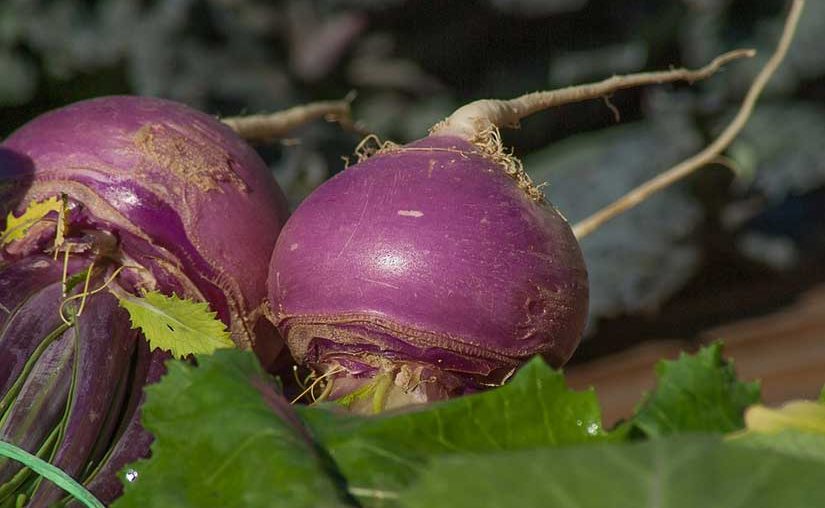The turnip is an old vegetable, whose good iron and calcium content makes it an ideal ingredient for winter recipes. Fearing drought, it is resistant to heat and especially moisture which allows it to be cultivated throughout the fall and harvested in winter. There are many varieties with different sowing periods. Discover all you need to know to sow turnips in your garden and make a good harvest.
The necessary equipment
Turnips are usually sown on site and need good soil, rich and loose. For this you will need gardening equipment:
- spade,
- claw,
- rake,
- chalk,
- hand seeder,
- watering can with apple.
Which varieties to favor?
It is possible to sow different varieties of turnips. To choose the variety you want, you must first of all take into account the harvest season. Some are harvested in summer and others in autumn until December. According to their declination, they change slightly in appearance:
- Turnip Yellow Gold Ball : turnip semi-hasty, round and flattened, of yellow color. Easy to keep for the winter. Its seedlings are between March and June, and from mid-July to September.
- Turnip of Croissy : long-rooted plant, white in color and early growth. Rustic, it resists both heat and cold. Its seedlings are from February to June, then in September.
- Red turnip of Milan : early variety, of white color and red drawing on purple. It is a round and flat turnip. Easy to eat thanks to its soft and sweet flesh. Sowing is done in the spring.
- Turnip of Nancy with whole leaf : early vegetable with firm flesh. It is round, white and purple collar. Its seedlings are from March to September.
- F1 hybrid 'Market Express' turnstile : turnip very early, round and white. It is harvested from 1 month to 50 days. Its sowing is from January to March, under cover, and from September to October, in the ground.
When to plant turnips?
Depending on the variety, you can sow turnips between February and September. Planting of spring turnips takes place between February and April, and between July and September for autumn turnips.
Here is a summary of the sowing periods according to the varieties, always in the ground:
- February to May : Whole Leaf Nancy, Croissy Turnip, Red Milan, Yellow Gold Ball, Market Express.
- July to August : Yellow Golden Ball, Nancy with whole leaf.
- September : Market Express, Yellow Gold Ball, Croissy Turnip, Nancy Whole Leaf
This early vegetable germ after 4 to 6 days, if the temperature is between 15 and 20 ° C, or 4 to 5 days if the temperatures are lower. However, you have to be more patient for the harvest. Count usually between 2 and 4 months after sowing to be mature. Autumn and winter turnips ripen the least quickly.
If you sow the turnips in good conditions, on a rich and moist soil, you will get beautiful vegetables, firm and fibrous. Ideally, the harvest of turnips is when they are still young. Thus, they will be even richer in taste and more delicious to eat alone, steamed or iced with butter, for example. Slightly bitter, they can be cooked in winter soups or as an accompaniment to other dishes.
How to sow turnips?
Sowing turnips in the ground, step by step
- Clear the soil from the stones and plow the soil to loosen it and rid it of weeds. Break the clods with a claw and use a rake to level.
- Sowing turnips online makes the harvest easier. For this, prepare furrows, spaced 25 cm apart, and 1 cm deep because the seeds must stay on the surface. Remember to space the seeds sufficiently to prevent the plants from getting bothered during the shoot.
- Hardly cover the ground seeds and tamp with the rake. Be sure to leave the seeds close to the surface.
- Water in fine rain with your watering can.
- Wait until your plants have 3 to 4 leaves to lighten. Eliminate less vigorous plants to leave only every 10 to 12 cm. This will leave room for those remaining to grow. Water regularly.
Sowing turnips in a bucket in 6 simple steps
Some varieties of turnips lend themselves to early cultivation. This is the case of Market Express hybrid F1 turnips and turnips of Milan Red. Sowing is done between February and June. For this you need:
- Put soil and compost into the buckets (60-40% split).
- Sow two or three seeds in buckets.
- Cover with a thin layer of potting soil.
- Tamp.
- Thin out when plants are 5 to 6 cm tall. Choose the best plants.
- Spray in the garden leaving at least 10 cm of space between each plant.
Our tips for a successful shoot
Choose the terrain well. As we explained to you, turnips need moist soil. Must therefore water regularly to avoid drought. It must not be too rich in limestone. In contrast, turnips are fond of land rich in potash and phosphorus.
Maintain and enrich your soil with compost during the season before sowing. If your soil is dry, thoroughly water the furrow before planting for emergence in less than 10 days. If this does not happen, it will be necessary to start again because a late germination gives fibrous roots.
Choose a sunny location. To sow turnips, you will need a very good winter exposure and some shade in the summer.
You have to choose the right combinations when sowing turnips. They get along very well with the weights and carrots that stimulate their production, but they are not good neighbors with Brassicaceae such as radish, cabbage or rocket.
The interview
If you want to sow turnips, you must first maintain your soil. For this, hoeing is essential. This keeps wet soil by facilitating the infiltration of water. In addition, hoeing is an effective technique for removing weeds. Mulching is incidental but welcome. You can make a fine mulch by using grass sprigs harvested when mowing your lawn. Finally, plan a crop rotation every 3 to 4 years because turnips quickly deplete the soil.
Even more plantations:









